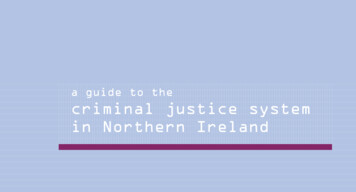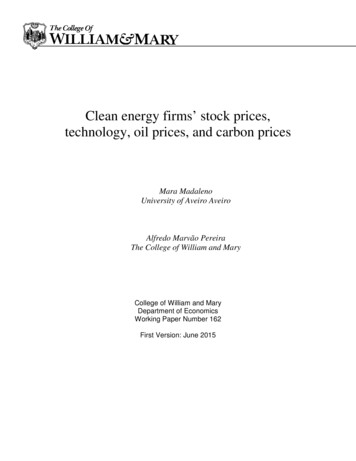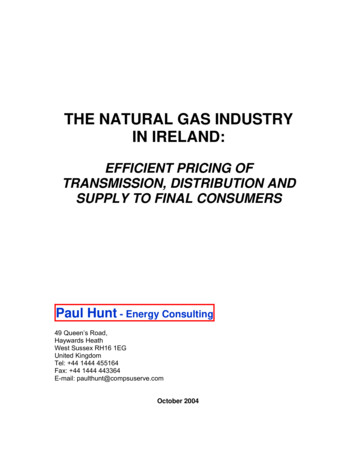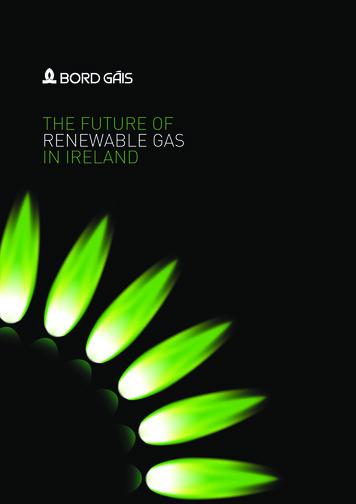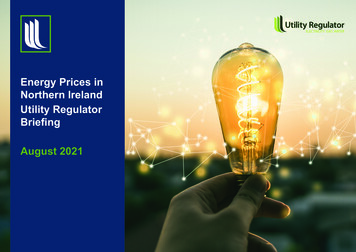
Transcription
Energy Prices inNorthern IrelandUtility RegulatorBriefingAugust 20211
Worldwide energy price increasesGlobal energy prices have risen tounprecedented levels during 2021. Wholesalegas costs in Europe have hit all-time highs withUK gas costs at their highest since 2005. Highwholesale energy prices coupled with risingdemand are putting extra pressure on reserves,rising scarcity and placing an upward pressureon costs. Other factors increasing the price ofwholesale gas include, for example: declining European productionhigher demand in Asia and South Americareduction of supply from Russiadepleted reserves - due to a longer andcolder European winterhigh price of carbon driving higher demandfor gasInternational market forces therefore impactedon energy prices in NI, GB and ROI. OFGEMannounced a 12% increase to the energy pricecap due to rising wholesale gas costs, bringingit to its highest ever level - 626/annum fordomestic gas comsumers and 812/annumfor domestic electricity consumers. Suppliersacross GB and ROI have also announcedincreases in tariffs because of worldwide fuelprice pressures.2
Overview of global costs increasesWholesale gas prices in July 2021 were 630% higher comparedJuly 2020. This has continued the trend of historically high gasprices.Gas Price (p/therm)Alongside the substantial increases in international gas prices, theprice of other key energy costs, including coal and carbon, havealso increased significantly.The graphs opposite show the extent of these increases over thepast year. Forecast prices for gas, coal and carbon see furthersteep rises as we move towards winter.3
Regulated gas pricesGas prices for domestic and business consumers are made up of a number of distinct elements within the gas cost chain, as shown below. Asthere are currently three distinct gas distribution areas in Northern Ireland (Greater Belfast, the West and the Ten Towns) the allocation of theseelements varies slightly.2%7%Operating costs50%41%Greater Belfast and the West (SSE)10% 2%KEYNetwork GasMarginWe scrutinise all elements that make upthe tariff and the cost allocation will changedepending on the level of each cost element,including the wholesale cost of gas.Cost allocation as of 1 April 2021452%36%Ten Towns (Firmus)
Gas tariff comparisons - NI versus RoI and GBGas prices in Northern Ireland have historically been below the averageprices seen in ROI and close to, or often below those seen in Great Britain.The gas market in Northern Ireland is less mature than the both the GB andROI markets yet our prices remain competitive.5
Regulated Gas PricesOur regulation of gas suppliers - overview In Northern Ireland we regulate the prices and SSE Airtricity Gassupply (for gas in the Greater Belfast and West areas) and FirmusEnergy (for gas in the Ten Towns area). We do this through periodic price control reviews of regulatedsuppliers’ costs and revenues. The price control reviews set limits on things like suppliers’ costs whichare then reflected in the regulated tariffs which customers pay.Why we regulate gas supply tariffsOur system of regulation in Northern Ireland ensures that regulatedtariffs always reflect the actual cost of supplying electricity and gas toconsumers.We have full sight of all the elements that make-up a customer’s bill.This price regulation is the equivalent of the price cap operating in GBand ensures that regulated electricity and gas prices in Northern Irelandcompare favourably to GB, and also to ROI.Our system of regulation in Northern Ireland also ensures that consumershave also a choice of non-regulated suppliers who compete against theregulated suppliers.We have commenced the tariff reviews of Firmus Energy in the Ten Townsarea and SSE Airtricity in Greater Belfast and the West. The companiescan request any changes to their tariffs based on their changing costs andseek approval from us. Any changes will take effect from 1 October 2021.Overall, a key context for these tariff reviews are the widely reportedincrease in the wholesale cost of gas. Forecasted gas costs haveincreased significantly in 2021, particularly for winter 2021.6
Regulated electricity pricesIn Northern Ireland we regulate the prices charged by Power NI for electricity. All electricity bills reflect thecosts to deliver the three key elements of the electricity system – wholesale, network and supply. Throughour price controls, tariff setting, scrutiny and detailed analysis we make sure the prices you pay reflectcosts.Breakdown of anElectricity BillTo protect consumers we continue to regulate the largest electricity supplier in NI, Power NI. We monitorprices continually and act quickly to reflect any savings in consumers bills. Although we do not priceregulate other competing suppliers, they are under pressure to keep their costs, and hence their prices,down to win new customers and keep their existing ones.Through our price control for Power NI, we also control the amount of profit the company is able to make.If the company makes more profit in a given period than our price control allows, we ensure this money isgiven back to customers through their tariff during the next period.We also review annually the network costs that make up part of the final consumer tariffs.Supply 10%Networks andrelated costs37%The cost of energy is the most significant element of the wholesale element of the tariff.with network costs making up the next largest portion of a consumer bill. Our scrutinyof electricity network charges will see reductions to the network element of the tariff forconsumers from 1 October 2021. As a result of our reviews, overall network costs will bereducing from 1 October 2021.Wholesale53%Power NI increased their prices by 6.9% which came into effect on 1 July 2021. Despitethe recent cost pressures seen in the wholesale electricity market, there are no immediateplans to increase the Power NI tariffs in 2021.7
Power NI tariff price comparisonsRegulated Electricity Prices – Power NI7000Oc 9t0Oc 9t1Oc 0t1Oc 1t12Jul1Oc 3t1Ap 4r15Apr1Oc 6t17Oct1Oc 8t19Jul20Jul21nt0JaOcJul050086008Annual Cost (Real) ( )800Recent non-price regulated suppliers tariff movements Click Energy 9% (from 1 September 2021)Electric Ireland 10.2% (from 1 August 2021)Budget Energy 14.9% (from 2 July 2021) and 3.9% (from 1 March 2021)SSE Airtricity 9.7% (from 1 August 2021)Bright Energy 20% (from 9 September 2021)8Power NI tariffs continue to fall belowthose seen in Great Britain and ROI.Although prices have risen in July2021, they remain below some of thehigher prices seen as recently as 2019and in previous years.
Wholesale Electricity PricesThe increases we have seen in international commodity costshave affected the cost of wholesale electricity. Higher gas, coaland carbon costs are driving up the prices seen across ourtrading markets with notable increases during the first six monthsof 2021 in particular.In addition, we continue to see higher costs in periods with lowerwind availability, and lower costs with higher wind availability.Wind availability has been particularly low over the past fewmonths as worldwide fuel prices rise. In July 2021, we saw a62% drop in wind availability compared to the same period lastyear. Low wind availability has been the main reason for a gapbetween prices in the SEM and the wholesale market in GB. Thislow wind availability, coupled with significant plant outages hashad a negative impact on wholesale electricity prices. As theselarger units return to service and levels of wind increase, the gapbetween the SEM and GB wholesale prices should close andreturn to similar levels.9
Helping keep costs as low as possibleOur system of regulation in Northern Ireland means we havecomplete transparency of all the costs that make up regulatedprices and we fully scrutinise each element of the tariff toensure it is justified. We have also taken further steps to helpplace a download pressure on costs for consumers by: announcing a reduction in network gas costs, which willreduce the impact of wholesale price rises to householdsby up to 20 a year.working with stakeholders including DfE and BEIS toimprove the efficiency of SEM-GB trading.scrutinising of electricity network charges will seereductions to the network element of the tariff forconsumers from 1 October 2021.scrutinising imperfection charges and will deliver areduction compared to the request of the system operator.increasing the levels of contracts, known as directedcontracts, directly accessible to smaller suppliers to helpduring this period of high wholesale prices.We have asked suppliers to provide support for consumers by: Adequately assessing customers’ ability to payBeing as flexible as possibleReminding them of their obligations to avoid customer disconnectionsAsking them to consider the Breathing space principles – providing protections for people in debtEnsuring they communicate directly with pre-payment meter customersAsking them to consider an industry-led financial hardship fund to support the most vulnerable customersReminding them of their obligations under existing codes of practice10
Key Market DataThe electricity and gas (in the Greater Belfastarea) markets have been open to competitionto domestic customers since 2007 and 1996respectively. However, there were no competingsuppliers in the electricity or gas domesticmarkets until 2010.The Ten Towns area opened to gas competitionfor domestic and small business customers inApril 2015 and there is currently one domesticsupplier in this area. There is currently one gassupply company in the west area also (SSE). Ascompetition grows, consumers will have accessto greater levels of choice. However, levels ofswitching show the continued reluctance of manyconsumers to change their energy provider.However we encourage consumers to1. Be aware of the suppliers in their area2. Consider the tariff they are currently on, ifon a standard variable tariff it is likely theyare not on the most competitive deal3. Check out other tariffs - the ConsumerCouncil for Northern Ireland (CCNI) hasan Energy Price Comparative Tool whichoutlines the electricity and gas tariffsavailable from every supplier in NI.Another factor that greatly determines the sizeof a bill is how much energy is used. Investing inenergy efficiency measures can also help reducebills.11
Key Market DataWholesale electricity costs in NI are the same as inRoI as they are drawn from the SEM. Wholesale costsin both GB and the RoI are higher than the majority ofEU countries. Several potential factors may drive thedifference between wholesale costs in the SEM and GBversus Europe: higher raw fuel input prices, generationmix, market design, policy differences and chargingstructures. Network costs in NI are significantly lowerthan the Republic of Ireland and are similar to those inGB comparator regions. The RoI allocates more networkcosts to household and small business customers – whichbenefits larger business customers. GB allocates morecosts to larger business customers than Northern Ireland.Regulators play their part through controlling energymonopolies, maintaining downward pressure on costs,fostering industry efficiency and promoting customerchoice and energy efficiency options. But other partiesimpact significantly on electricity prices: industry, by ensuring energy efficiency and least costin their actions and consumer pricesthe relevant Government Departments, through settingenergy policy and strategic priorities; andcustomer representative bodies, in ensuringcustomersare active and educated about their energy choices.We continue to work with all key stakeholders to helpidentify any potential cost savings and efficiencies forconsumers.12
13
Regulated gas prices Gas prices for domestic and business consumers are made up of a number of distinct elements within the gas cost chain, as shown below. As there are currently three distinct gas distribution areas in Northern Ireland (Greater Belfast, the West and the Ten Towns) the allocation of these elements varies slightly.
